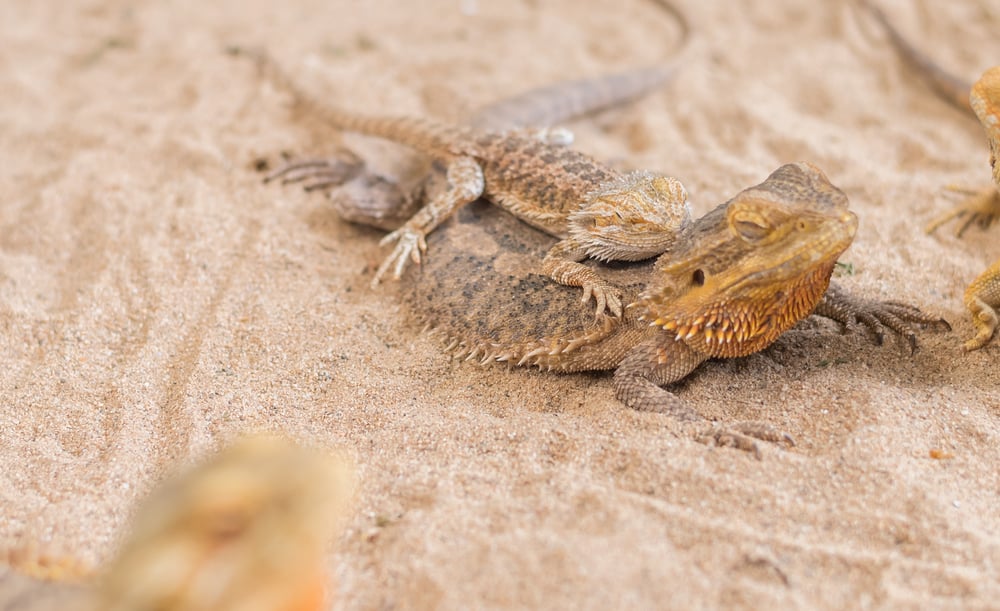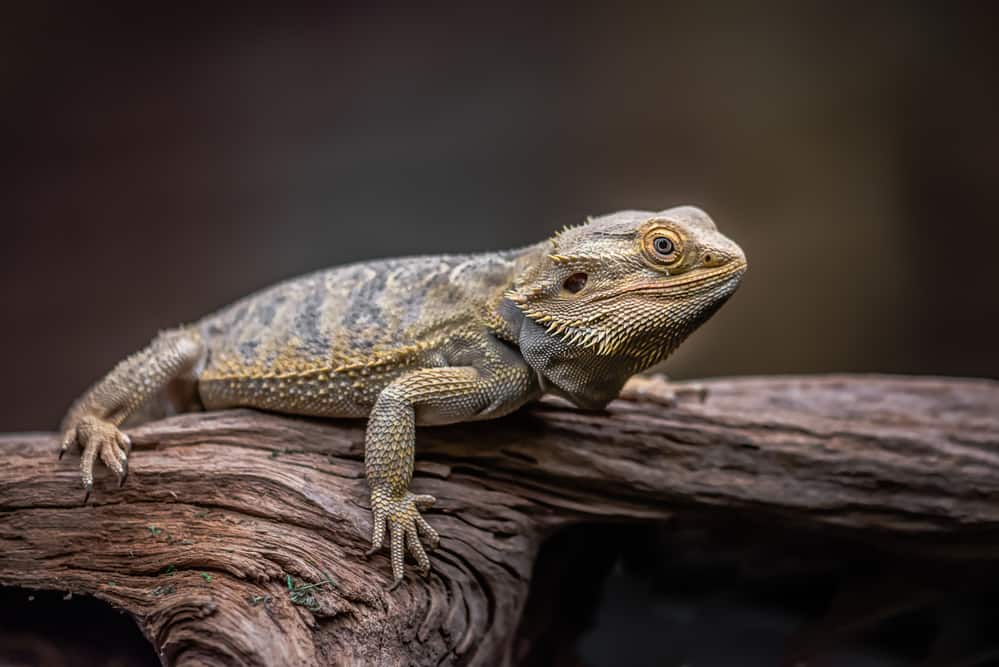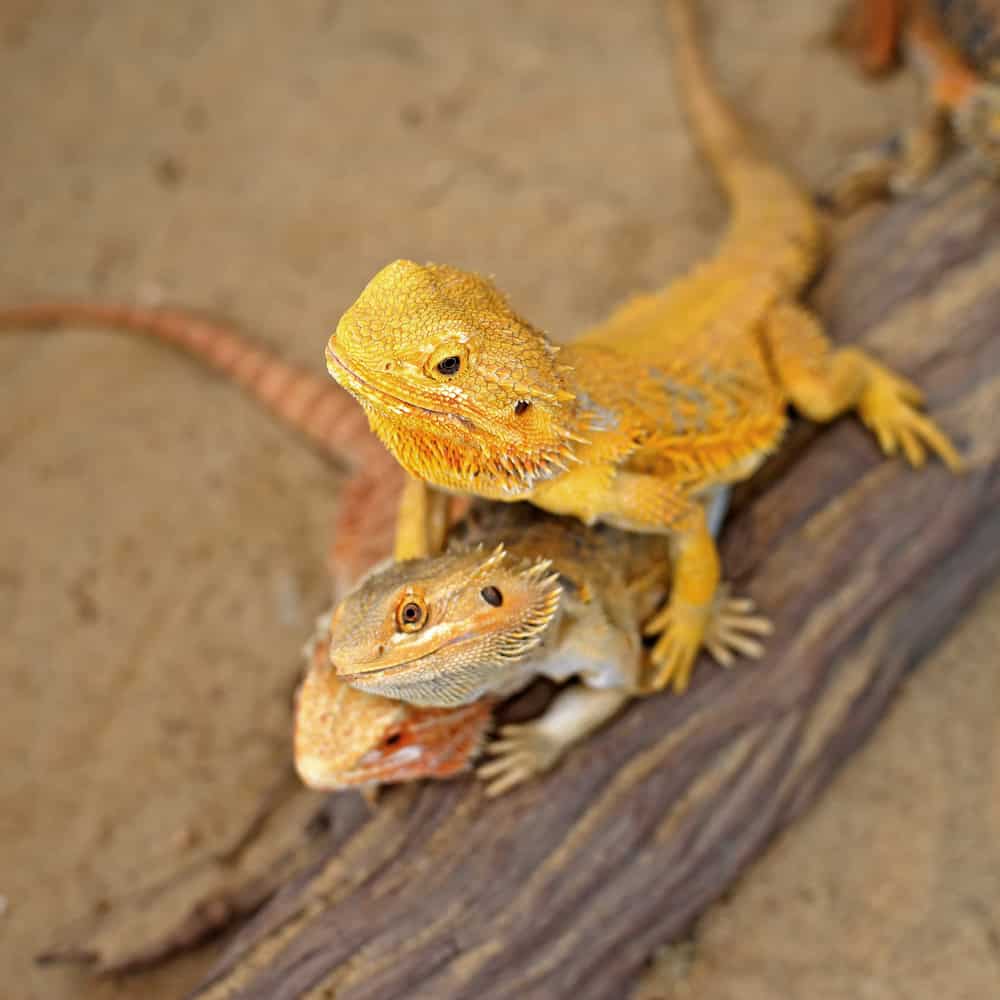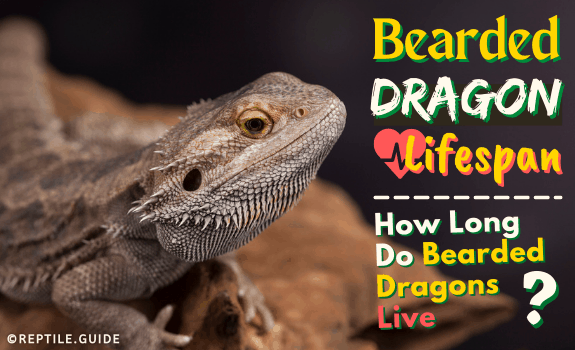Bearded dragons are incredible lizards and make excellent exotic pets, but bringing any pet into your life is a huge commitment.
Did you know that the world’s oldest bearded dragon lived to be 18 years old?
Beardies are easy reptiles to keep in many regards, but it’s vital to know exactly what you are getting yourself in for!
In This Article
What You’ll Learn
In this article, we’ll answer all of your most pressing questions about bearded dragon lifespan, such as:
- How long do bearded dragons live?
- How long do bearded dragons live without food?
- What is the maximum bearded dragon lifespan in captivity?
- What is the average lifespan of a bearded dragon/bearded dragon life expectancy?
To learn more about other aspects of bearded dragon care, check out our comprehensive care guide.
Bearded Dragon Background Information

Bearded dragons are agamid lizards native to Australia.
As pets, they’re sought-after for their easygoing nature and relatively simple care requirements.
“Beardies” are named for their spiny, “beard-like” throat pouch.
By inflating this pouch, dragons can intimidate rivals, deter predators, and impress potential mates.
Scientists have described seven species of bearded dragons to date, which are:
- Western Bearded Dragon (Pogona minor)
- Central Bearded Dragon (Pogona vitticeps)
- Eastern Bearded Dragon (Pogona barbata)
- Northwest Bearded Dragon (Pogona mitchelli)
- Rankin’s Bearded Dragon (Pogona henrylawsoni)
- Kimberley Bearded Dragon (Pogona microlepidota)
The central bearded dragon (P. vitticeps) is the most common Pogona species in the pet trade.
Bearded Dragon Life Expectancy
A bearded dragons’ life expectancy (average age of death) is between eight and twelve years in captivity.
In the wild, their life expectancy can range from five to eight years.
Average Lifespan of a Bearded Dragon
The maximum lifespan of a bearded dragon is 18 years, but most don’t live that long.
On average, these lizards survive to around ten years old in captivity.
In the wild, this tends to be even shorter.
Bearded Dragon Lifespan in Captivity
The bearded dragon’s lifespan (maximum age) is 18 years.

The oldest bearded dragon ever was a male central beardie (Pogona vitticeps) called Sebastian.
He was born on June 1st, 1997, and died on January 24th, 2016, having made it to 18 years and 237 days old!
Sebastian lived in the UK, and the Guinness Book of World Records will forever immortalize him.
No doubt, another lucky lizard will one day break Sebastian’s record for long life.
Who knows, with excellent husbandry – and a bit of luck – perhaps you could be the first to raise a 19-year-old beardie!
Factors That May Impact a Bearded Dragon’s Lifespan
Before you start to get too excited, remember that not all beardies are destined for a life as long as Sebastian’s.
Several factors can impact the average lifespan of a bearded dragon.
We’ll discuss each of these in the next section to help you give your bearded dragon the best chance at a long life.
Genetics and Species
Different Pogona species have slightly different lifespans. There are also other genetic factors that can influence the longevity of bearded dragons.
The central bearded dragon (Pogona vitticeps) is the most common captive bearded dragon species.
Central beardies also have the longest lifespan (up to 18 years).
Smaller species – such as Rankin’s dragon (Pogona henrylawsoni) have slightly shorter lifespans than P. vitticeps – not usually exceeding ten years.
Bloodlines with an exceptionally high degree of inbreeding can be more prone to health issues.
These bloodlines will have a lower life expectancy as a result of a higher probability of genetic disease.
In the past, there have been morphs associated with “sickly” characteristics, such as excessively inbred “translucent” (or “trans”) bloodlines bred for an overall bluish hue.
Today, “silkbacks” are perhaps the only popular morph known to have any specific health issues that could affect their lifespan.
Most breeders will stop breeding a pair if they appear to produce sickly offspring.
Thanks to responsible breeding practices, we now have little reason to worry about the longevity of even the most stunning bearded dragon morphs.
Husbandry
Most bearded dragons are capable of living a long and happy life.
The most common cause of premature death is improper care or husbandry.
Neglecting to care for your animal’s specific environmental, dietary, or enrichment needs will cause it to develop health issues that shorten its lifespan.
Thankfully, this is easy to avoid, provided that keepers are willing to do their research.
Ensure that your beardie’s environment is safe and hospitable by following care guidelines properly. In short, this means:
- Places to hide – Hides are essential to prevent stress
- Plenty of space – 40-gallon vivarium (minimum) for adults
- Sufficient lighting – 12-14 hours of UVA and UVB exposure per day
- Appropriate humidity – Around 30-40% is ideal for preventing respiratory issues
- A diverse, balanced diet – Nutritious, gut-loaded feeder insects, fruits/veggies, and calcium/vitamin supplements
- Regular enclosure maintenance – Daily spot cleaning and occasional complete substrate changes
- An appropriate temperature gradient – Ranging from 95-110 F on one side and 65-80F on the other
- An appropriate substrate for bearded dragons – such as reptile carpet, substrate tiles, or excavator clay
By meeting each of these needs, you can offer your beardie the best possible chance of living to a ripe old age!
We’ll talk more about diet in the next section.
Diet and Obesity
Bearded dragons are omnivores and have evolved to survive well on a diet of insects and plants.
Like humans, these lizards require a balanced diet to stay healthy.
A healthy supply of macronutrients, vitamins, and minerals will allow your lizard to stave off disease and ultimately live longer.
A well-formulated diet for bearded dragons should include:
- Leafy greens – Left in the enclosure seven days a week for your lizard to graze as it pleases
- Feeder Insects – Offered around six days a week
- Vegetables – Offered about four days a week
- Reptile-safe fruits – Offered once a week
You must also incorporate calcium and multivitamin supplements into your lizard’s diet.
Adhering to a good schedule and encouraging a balanced diet is an excellent way to maintain your lizard’s overall health.
To learn more about achieving a healthy dietary balance, check out this handy bearded dragon food pyramid.
Obesity and metabolic bone disease (MBD) are the most common diet-related health issues that bearded dragons can develop in captivity.
Obesity is common in bearded dragons as many keepers overfeed their lizards.
Though feeding time can be an enjoyable experience (for keeper and lizard alike), never feed your beardie more often than is needed.
Another cause of obesity is an excess of fat in the diet.
Waxworms, mealworms, and superworms are examples of high-fat feeder insects that should be fed only as occasional treats.
Insects lower in fat – such as crickets or dubia roaches – should make up a higher proportion of your lizard’s diet.
A poor diet or lack of supplementation can also lead to severe nutrient deficiencies over time.
These issues will ultimately result in life-threatening conditions such as metabolic bone disease (MBD) if left untreated.
MBD is caused by a chronic calcium deficiency.
When calcium levels become critically low, the body starts to remove calcium from bones to maintain organ and muscle function.
This condition generally occurs due to improper diet (high phosphorous or low calcium/D3).
Thankfully, MBD and other deficiencies are usually treatable. Just be sure to heed warning signs early on.
The most crucial early warning signs of a poor diet are as follows:
- Obesity – Caused by overfeeding or an excess of fatty foods
- Runny poops – Can be caused by feeding inappropriate foods such as lettuce
- Emaciation – Caused by underfeeding or a lack of proper nutrition
- Constipation – Can be due to a lack of fiber or difficulty digesting certain foods
- Yellowish poops – Indicates an excess of calcium
- Mouth hanging open – A common symptom of MBD, caused by calcium deficiency
- Yellow-tinged urate (part of the poop that is usually white) – A sign of dehydration
If your lizard begins to exhibit any sign of nutritional issues, consult a specialist veterinarian right away.
It may save your lizard’s life if caught and dealt with quickly.
Stress
Though we all feel stress from time to time, stress can be a complex condition to define in the field of biology.
It is essentially a non-specific, adverse response to an unfavorable situation.
Stress can be acute (such as when an animal sees a predator and becomes stressed immediately in response).
It can also be chronic – occurring over a long period, resulting from an ongoing or repeated stressor such as disease or an unfavorable environment.
Chronic stress is particularly harmful to the health of any animal, and impacts immune system function, appetite, and behavior (along with many other things).
These effects can shorten your beardie’s lifespan considerably if not dealt with quickly.
Common causes of chronic stress include (but are not limited to):
- Poor diet
- Lack of shelter
- Excessive handling
- Lack of enrichment
- Regular, loud noise (such as loud music)
- Poor environmental conditions (temperature, humidity, enclosure space)
If your bearded dragon is chronically stressed, it may stop eating or turn a darker shade of brown.
It may also perform unusual, repetitive behaviors (such as glass surfing).
Do not ignore these signs. You must try to de-stress your beardie as soon as possible.
Infectious Diseases and Parasites
Infectious diseases are pretty common in reptiles (especially those under chronic stress).
These conditions usually occur as a result of a viral, bacterial, or parasitic infection.
In this section, we’ll talk about a few of the most common conditions that can reduce your bearded dragon’s lifespan if left untreated, namely:
- Parasites
- Mouth rot
- Adenovirus
- Respiratory infections
Parasites
Internal parasites are common in the gut of many lizards (including the bearded dragon).
Mild infections usually lack symptoms – and can be entirely harmless.
When bearded dragons become stressed, parasites can become a severe problem.
Diarrhea and rapid weight loss are the main symptoms of a severe infection.
Internal parasites such as pinworms appear in feces, making them easy for a vet to detect and treat if symptoms do occur.
External parasites – such as mites and ticks – are standard on wild-caught specimens.
They can also be transmitted between individuals sharing an enclosure.
External parasites are usually visible to the naked eye and are easy to treat – once spotted – using a medicated bath.
Mouth Rot
Mouth rot (infectious stomatitis) is a bacterial infection of the gums. It can also spread to the jaw bone, causing severe swelling.
The most recognizable symptom of mouth rot is an oozing discharge from the mouth.
Like many infections, mouth rot is often a result of poor tank hygiene.
Keep on top of regular tank maintenance and deal with feces and spillages quickly as they occur. Your bearded dragon will thank you for it.
Respiratory Infections
Respiratory infections are common diseases in all reptiles.
These are typically a result of stress, incorrect humidity or temperature, or an unhygienic enclosure.
Symptoms include wheezing and sneezing, along with bubbles or mucus secretions from the eyes, nose, and mouth.
An infected lizard will likely also lose its appetite, becoming sluggish and inactive.
You must treat respiratory infections immediately with vet-prescribed antibiotics.
Maintain a humidity level within the range of 30-40% and provide a suitable temperature gradient.
Doing so will significantly reduce the likelihood of respiratory infection.
Atadenovirus
Atadenovirus – sometimes also known as adenovirus – is a life-threatening viral condition to which bearded dragons are highly prone.
It’s particularly common among hatchling and juvenile lizards.
The most notable atadenovirus symptom is “stargazing.”
“Stargazing” is a condition in which lizards become stuck with their head and back arched upwards in a stiff, uncomfortable position.
This symptom usually lasts for extended periods and is involuntary.
Other symptoms include:
- Lethargy
- Loss of appetite
- Unusual bodily swelling
Unfortunately, there is no known cure for atadenovirus. Fortunately, we have a dedicated article on the atadenovirus.
The best way to deal with this disease is to scan new lizards for symptoms BEFORE bringing them home.
Atadenovirus is highly contagious, so keepers must avoid bringing infected animals into their collection at all costs.
Veterinary Care
Like with any animal, bearded dragons need a routine veterinary checkup once per year. Ensure that you have a reptile veterinarian in your area.
Your vet will likely check your lizard’s body condition for any signs of chronic diseases.
They should also check a stool sample for parasites and perform blood tests to assess the overall health of your beardie.
Your beardie may experience some short-term stress resulting from the experience but will ultimately be better for it!
Purchasing a Healthy Bearded Dragon
When purchasing reptiles, you must do your best to source and select the healthiest animals.
This entails researching sellers thoroughly and reading customer reviews.
It’s also imperative to know how to identify a healthy dragon before you buy.
Most first-time reptile owners purchase from large pet stores.
Though they are convenient (and offer competitive prices), pet stores have a couple of significant downsides.
Firstly, most large pet retailers obtain their beardies in large quantities from breeders but do not breed reptiles themselves.
Pet store staff are (usually) less knowledgeable about reptile husbandry than breeders and notorious for providing incorrect or misleading advice.
Second, large pet stores tend to keep or transport animals in large groups. These conditions increase the likelihood of disease spread.
Reputable breeders are far more likely to understand the specific needs of bearded dragons.
They may also be willing to remain in contact and answer any questions that you might have in the future.
Breeders are likely to be able to put you in touch with a local reptile veterinarian. This connection will undoubtedly be helpful later on!
Finding a reputable breeder can be easy, depending on your area.
Ask around – consulting local Facebook groups or online forums are an excellent way to find out more about breeders in your region.
Reptile fairs or expos are another way to meet potential breeders. These events also offer the chance to find rare or unusual morphs.
Take the time to find a reputable seller and checking lizards for common diseases.
These simple steps will significantly increase the likelihood of your dragon surviving to a ripe old age.
How Long Do Bearded Dragons Live Without Food?
A healthy, mature adult bearded dragon can survive for up to two months without food before succumbing to starvation.
For young lizards, this is considerably less.
Your bearded dragon may lose its appetite when under stress or suffering from a severe health condition.
Brumating dragons also go long periods (weeks or even months) without food.
Ordinarily, your beardie will resume eating when it is ready, and the stressor, disease, or period of brumation has ended.
Keepers may still (understandably) worry about their pet’s wellbeing during these times!
To learn more, check out our article on how long bearded dragons can go without food.
Healthy Bearded Dragon Growth Rate
If you meet all of their needs, your bearded dragon may exceed ten years of age.
They’re also likely to grow up to two feet in length (dependent on species).
Male beardies typically outgrow females by three to four inches.
Data concerning growth rates of smaller Pogona species are sparse, but Pogona vitticeps’ growth rate is well documented in captivity.
Health conditions or a poor diet can stunt reptile growth dramatically.
P. vitticeps are usually around three inches long at the time of hatching. These hatchlings can weigh as little as four grams!
Within the first couple of months, they can double (or triple) their total length.
Juveniles (aged three to eleven months) can reach as much as 23 inches by their eleventh month of life!
Bearded dragons experience their most dramatic growth spurt at this age.
12 to 17-month-old beardies are known as “sub-adults.” Sub-adult beardies grow exceptionally slowly, barely changing in size.

Bearded dragons aren’t proper “adults” until they hit sexual maturity. This change usually occurs around the age of 18 months.
For further reading, check out our dedicated article on the topic of bearded dragon growth rates.
And if you just can’t get enough about beardies, why not check out the best bearded dragon memes we’ve found so far? They’ll be sure to brighten your day.
